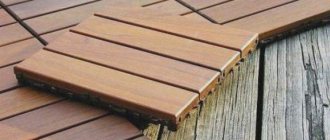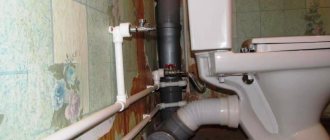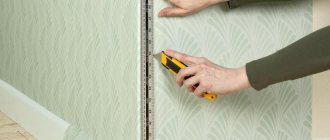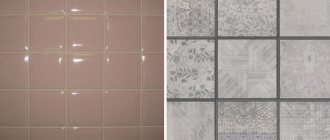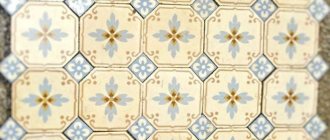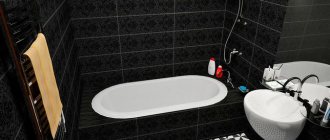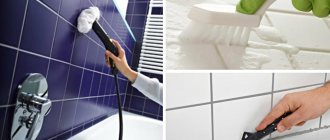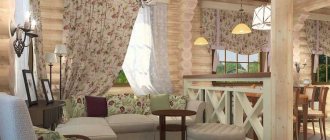Peculiarities
Decorative corners are used during the final stage of renovation.
The main purposes of the corners:
- give the finishing touch to the decorative design;
- neat and stylish design of the joints between tiles and plumbing fixtures, especially when it comes to difficult areas of the room;
- Use during refinishing or upon completion of renovations.
Depending on the shape, experts distinguish two types of corners.
- External. Use to design a convex corner. The main purpose is wall decoration. Thanks to them, sharp parts can be covered simply and practically.
- Internal. They are chosen when you need to design a concave (internal) corner. If you need to level the surface between the tiles and the bathtub or create a corner, choose corners of this type.
From a design point of view, corners can be divided into two groups:
- Decorative. During the manufacturing process of these elements, special attention is paid to the appearance of the product. They can have different colors and shapes depending on the style. The material most often used for manufacturing is ceramics or PVC.
- Functional. This is the main group of corners presented on the modern market. They are characterized by increased reliability, stability and practicality.
Stair corners
Corners for steps have meaning depending on the type of layout, the nature of the tiles and the purpose of the staircase. Sometimes elements are necessary, sometimes, on the contrary, they get in the way. They come in two types:
- invoices;
- with groove, perforation and face area - similar to those we have already described.
The purpose of overhead corners is to provide slip resistance. They are simply necessary on the porch, no matter what the surface of the tiles is: smooth or rough. Water and snow reduce traction on steps, so an additional anti-slip element is normal. You need to understand that on stairs any secondary structure both helps and hinders. By acquiring good grip, we reduce the working potential of the steps. Corners contribute to the concentration of moisture at the joints, which destroys the stairs in the autumn-winter period. To increase the service life of the stairs, it is recommended to make gaps between the corners to allow water to drain.
Corners of the type already known to us, unlike overhead corners, perform rather a decorative function. How beautiful it is is the question. But such layouts ultimately do not contribute to the durability of the stairs in most cases. The reason for this, again, is the liquid and a decrease in the solidity of the steps. Although there is a functional advantage - the corners protect the joints from chipping, taking part of the load upon themselves.
Where will corners be needed?
Trimming tiles is inevitable when decorating walls with this facing material for a number of reasons:
- the most aesthetic option for laying out tiles is “from the middle”, the tiles are cut in both corners;
On the boxes, all tiles are cut to obtain a beautiful layout without narrow and asymmetrical pieces. - the edge of the cut is very rarely perfectly smooth, the glaze may chip;
- If the finisher is not sufficiently qualified, the tiles may turn out shorter than the required size.
Therefore, you have to seal the joint with grout or initially use a special profile that allows you to hide minor defects. A corner seam occurs at the junctions of the following surfaces:
- wall/wall – internal vertical;
- wall/ceiling – internal horizontal;
- wall/floor – horizontal internal;
- wall/bath – internal horizontal;
- wall/wall – vertical external;
- wall/slope – external vertical and horizontal.
Important: In a separate bathroom with brick walls, the last two options are rare, since communications, metering devices, shut-off valves are often located near the toilet, that is, the boxes are built inside the toilets.
The joint between the bathtub and the wall needs not only finishing, but also sealing against leaks.
External corners for tiles
External corners from a decorative and operational point of view are more demanding in terms of the use of additional elements. If you don’t make a bevel, there is only one worthy option left - an external corner for the tiles. Without using either one or the other, you cannot get a beautiful finish; Overlapping tiles look ugly in most cases.
Structurally, the outer layout is a little simpler than the inner trim. The most popular sizes: 7-11 mm. The length of the standard element is 2.5 m.
Installation of external corners
Unlike internal corners, external corners are almost always mounted only in the standard way; cutting and installation on silicone is not practiced (with the exception of profile repairs). This is logical - the outer corner usually has a shape that does not require caulking with any composition. The order of work is also different: very rarely the installation of trims is left to the final stage. It is possible, but difficult, to calculate the distance between the tiled walls (under the corner). A small mistake can lead to a complete overhaul. Therefore, it is much more reasonable to install as work progresses.
So, the outer corner is attached to the outermost row of tiles. You need to use a layout of a suitable format. If it is not possible to purchase a corner of the required size, it is better to buy a slightly larger one. A smaller one is not needed - the tile will not fit into the groove. Although in this case there is a way out. It consists of using a grinder to deepen the back side of the tile to the width of the layout. A slightly larger corner will require more glue. It won’t hurt your pocket, but it will force you to tinker with installation, since you will have to use a comb (notched trowel) of a different format.
You can place the corner behind the tile on both sides: with the perforated part towards the finished cladding or towards the future one. The first option is recommended. The second is resorted to in cases where, for some reason, the outer tile was not cleared of glue or, moreover, of cement-sand mortar. To avoid labor-intensive cleaning, you can turn the trim upside down.
Direct installation of the outer corners involves applying glue to the trim and/or to the back of the tile. It can be difficult for beginners to decide on a layer, but the recipe is always the same: it is better to spread more than vice versa. The plastic mixture will find its way out of the joints in any case, but a lack of glue can lead to voids and almost guaranteed destruction of the tile. The perforation must be adjacent to the ceramic tightly, parallel, otherwise the working area of the corner will be curved, and it will become impossible to place perpendicular tiles.
Even if the tiles are laid on mortar, the joints should be stamped with tile adhesive. The solution does not have the necessary plasticity, and it is difficult to guess the right amount. Too much mixture - the tiles will not lie down; too little - even worse, there will be a void under the tiles.
Cutting outer corners
Shortening the corners is easy, cutting the working edge is not so much. To join the layouts, you need to cut one of the sides of each at an angle of 45 degrees. It is best to make the cut using a miter box. Trimming by eye is possible, but requires more skill, otherwise there will inevitably be a gap between the trims. The most difficult parts to cut are the outer corners, which are mounted both vertically and horizontally. In this case, special skill is required. If a similar task arises when installing plastic corners, the joint is created in the form of a recess, which is subsequently rubbed with a grout. The nature of metal layouts also contributes to another variation - one of the elements is cut off with an overlap, which, after the glue has set, is carefully bent with a hammer and sharpened with a grinder.
Some, more expensive, corners come complete with plugs that effectively mask the wide joint - this is the best option. In this case, complex pruning is not necessary, and the result is much more impressive.
The profiles are cut with a hacksaw or angle grinder. The grinder is much easier and faster, but it eliminates the use of a miter box. Therefore, a power tool is appropriate for straight cuts and, if you have a good eye, for installing metal corners.
Sometimes, when working in a room with a future suspended ceiling, installing corners on a column or semi-column, the excess is not cut off - it is left for later for yourself or other workers. Precise trimming is considered the norm - if the ceiling rests on the tiles, cutting trims will be very inconvenient. The same goes for gender.
Advantages and disadvantages
Before using the above items, you need to familiarize yourself with the advantages and disadvantages of this product.
Pros:
- due to reliable adhesion at the corners, the strength of the walls increases;
- the work of installing tiles becomes easier due to the absence of the need to trim the material;
- decorative design acquires accuracy and sophistication;
- increased level of safety - additional elements cover sharp parts that can cause injury;
- protection against mold and mildew in tile joints;
- the level of tile resistance to moisture increases;
- In the process of cutting tiles, the percentage of chipping decreases.
Due to the above advantages, structural elements are the best option for renovation work in the bathroom. They have a positive effect on the appearance of the room, facilitate the work process and improve the performance of the finishing material.
The parts also have certain disadvantages.
They are related to the materials used in manufacturing and some other aspects:
- After a certain time, corners made of white plastic begin to lose their former whiteness, acquiring a yellow tint. Designers recommend using colored or dark elements whenever possible.
- If a small gap is formed during the installation of a plastic profile, moisture will accumulate in it.
- Installation of ceramic products is difficult. During the process, you must be as careful as possible so as not to damage the product.
- To ensure that chrome corners retain their shine and shine for a long time, do not install them on a surface that you will touch frequently.
- Perfect evenness is necessary when installing metal corners, since it will be impossible to correct this later.
Materials
Manufacturing companies use various materials to produce corners. Each of them has its own performance characteristics.
Metal
Designers call aluminum products the optimal choice for most stylistic trends. Lightweight and durable metal harmonizes perfectly with sanitary ware, bathroom furniture and a wide color palette. Elements of this type are ideal for working with outdoor tiles.
In terms of strength and hardness, the leading positions are occupied by corners made of stainless material. Due to its special properties, it is ideal for use in rooms with high humidity. As a rule, they are made in gold or silver. Often there are options plated with brass, chrome and nickel.
Chrome elements are an ideal choice for high-tech style.
PVC (plastic)
The products are lightweight and particularly flexible. Manufactured in a variety of colors. Can be used at any stage of gluing. In terms of price, this is the most profitable option, and therefore widespread.
Ceramics
Ceramic models attract attention with their expressive appearance. They stand out from the rest with their decorativeness, patterns and expressiveness. If tiles were used to decorate the bathroom, ceramic corners are ideal.
How to lay tiles in corners: basic rules
There are several options for connecting tiles:
- Perpendicular connection. The simplest way to solve the problem is a direct connection. In this case, the tiles are laid at 90 degrees, that is, one cut remains open, and the second is disguised under the top element. This way you can close any corner with minimal effort. If tile trimming is required, it is best to install the cut from below. The disadvantage of this method is the seam when connecting. Subsequently, it is masked with grout, but it is still visible on the surface.
- Trims. The most popular option is probably the installation of special elements - trims. This is a plastic profile that forms the necessary direction. For external corners, an L-shaped installation is used. The internal corner has the shape of an arc. Sometimes narrow convex trims are used.
- Pruning. This method is based on trimming the edge of the slab. It is performed in such a way that the fragments can be connected to each other at 45 degrees.
Perpendicular arrangement
The simplest solution to the issue is direct docking. In this case, the elements are laid perpendicular to each other, that is, so that one cut remains visible, and the other is hidden under the upper fragment.
Expert opinion
Roman Vasiliev
Builder, repairman
In this case, a corner in any part of the walls is closed with minimal effort. If adjustment of the tile is necessary, it is advisable to place the cut edge under the bottom. The disadvantage of this method is the presence of a seam at the junction. Later it is sealed with grout, but this still affects the appearance of the surface.
Options for laying tiles at internal joints
There is another way to join tiles perpendicularly in the corners. This method is suitable, for example, for finishing curbs or bathroom frames. The main condition is that the cladding should not be visible from below.
The essence of the method is as follows: it is necessary to glue the tile so that the horizontally located (top) tile hangs over the edge. The corner will turn out neat if the width of the canopy is within 3-5 mm. The only condition is that the edge must be solid.
Edge Trimming
For more accurate work you will need special equipment. The method is based on cutting the edge of the tile at 45 degrees. The task is performed in the following ways:
- grind the edge with a grinder;
- a tile cutter is used;
- sandpaper is used.
The best option is to process tiles with an electric tile cutter with an inclined bed.
How to lay such wall tiles? For this purpose, the tiles are cut and glued with mortar into the corner so that their edges coincide and form a solid covering.
Don't miss: How to seal the joint between a bathtub and tiles: a description of how to carry out the work. How to glue a ceramic border to a bathtub
One way to lay tiles in internal and external corners is to trim the chamfer at 45 degrees.
For beginners, laying tiles in the bathroom using this method is not easy. If possible, practice on unnecessary material. Please ensure that the surface of the walls is as smooth as possible, otherwise you will need to lay a layer of glue of different thicknesses on it, which will disrupt the position of adjacent elements.
Using Trims
These are special inserts. The method using them is the most popular. They are a plastic profile that forms the angle of the desired direction. An L-shaped pad is used for external projections. And the inner surface has the appearance of a concave arc. Narrow convex models are also used.
One more important issue needs to be resolved - how to glue the plastic corner to the tile. Several options are possible:
- sealant;
- glue;
- liquid Nails.
Often, such trims have a special design that allows them to be laid on the solution. A special plate is driven under the tile and fixed with tile adhesive. This installation is extremely simple, the surface acquires a neat appearance, and the joints are protected from moisture and bacteria.
Some options for cladding inserts
The external plastic corner and trims at the junctions with the plumbing (curbs) are fixed differently, for example, using silicone or acrylic sealant. How exactly to glue the plastic to the tiles in the bathroom does not make much of a difference. This type of finishing of walls or corners of the box is suitable for almost any type of material.
Existing methods for joining tiles in corners
- Arrangement of the angle using trims.
- Perpendicular arrangement of tiles of adjacent walls.
- Trimming tiles at 45 degrees.
- Installation on the outer corner of a special format tile.
To correctly select the method for designing the intersection of adjacent walls, we will describe each of the listed methods in more detail.
Trim method
The most common method, of course, is the use of special devices - trims. This is a decorative profile forming an external or internal corner. They come in a wide range of colors, which allows you to match this element to almost any color of wall tiles. Made from metal or plastic.
The use of special corners - trims
The external corner is formed using L-shaped convex trims. To install the internal corner, trims with a concave arc are used; they can also be used as a kind of plinth when transitioning tiles from the walls to the bathroom floor. In addition, using trims, joints of different types of ceramics are made on the same wall plane.
Along with the aesthetic and decorative qualities of decorating an external corner using trim, the profile perfectly protects the corner from various types of mechanical influences. The advantages include the relative simplicity of the work performed and the absence of the need to use special tools and equipment.
The profile can be glued using silicone or acrylic sealant, liquid nails or special adhesives. There are some designs of trims that allow their installation on an adhesive solution used for facing the main body of tiles, while part of the trim goes under the tile and is glued there with an adhesive mixture. Cladding the walls and corners of the box using this method is applicable to any type of tile.
Trims are available in plastic, aluminum, chrome, various colors and sizes
There is also a simplified version of trims on sale - this is a decorative corner. It is placed around the perimeter of door and window openings, and is mounted on the tile mortar of the vertical row of one of the walls, and the tile of the vertical row of the other wall is adjacent to the product butt-to-end.
It is advisable to make the outer corner of the bathroom walls with whole, uncut tiles.
Ceramic tiles in the bathroom
This is the usual laying of ceramics end-to-end, and is the easiest way to lay tiles to form a corner of a wall or box. In this option, you need to glue the tiles at 90 degrees of one element relative to the other. As a result, one end of the tile is covered with the top tile, and the second is visible.
If the joining is performed using a cut fragment, then it should be done at the bottom, covering the cut with a whole tile.
There is another option for perpendicular joining of elements at the intersection of walls; it is applicable for the installation of curb protrusions. The principle of the method is that the horizontal top tile must be glued with an overhang over the vertical row. The edge of the protruding tile should be without a cut and overhang no more than 4-5 mm, then it will look beautiful and aesthetically pleasing.
Laying tiles on the floor begins from the center of the room
The method is applicable only if it is impossible to view the finish from below.
Trimming the end of the tile
Let us immediately make a reservation that for the high-quality implementation of this method it is mandatory to have special equipment and the appropriate skills to perform this type of work. This task is very complex and time-consuming; it is necessary to cut the tiles of adjacent walls at an angle of 45 degrees, so that at the junction an angle of 90 degrees is formed. Washed down elements can be done in three ways:
- Using an electric tile cutter with a diamond blade.
- Make a cut with a grinder.
- Make the required cut using sandpaper.
You will need a tile cutter to cut the end of a tile.
Laying tiles in this way is a difficult task for a person who does not have the appropriate skills, and therefore it is advisable to practice on unnecessary fragments. The sawed-off elements must be glued in such a way that the undercuts of adjacent tiles fit perfectly together, forming a right angle.
To obtain a straight line, it is best to make a cut using an electric tile cutter with an inclined bed.
Making a joint with specially shaped tiles
And finally, the method is to lay a corner using a tile made in a special way in the form of two perpendicular elements creating an angle of 90 degrees. Such a product must be glued using the same adhesive mixture as the main body of bathroom wall cladding. In this case, the tiles should be laid away from the product.
Elimination of possible defects
There is no need to be very upset if minor defects arise during the execution of work. Even professionals sometimes make some mistakes, the main thing is to know how to correct them without damaging the overall appearance.
- If, when tiling, the joint of the walls turns out to be uneven, you can correct the situation by adjusting the layer of adhesive mixture under one or another tile.
- If the required 45-degree cut is not formed during the cutting of the material, then a more precise fit can be achieved using sandpaper.
- In case of flaws at the junction, there are two methods to solve this problem:
- possible joint defects are treated with standard joint grout;
- chips and gaps are covered with a decorative profile, which can be glued with silicone sealant or liquid nails.
Preparatory activities
Before tiling a corner, you should think about carefully preparing the walls and floor themselves.
- They are pre-aligned so that the material does not peel off over a short period of time.
- Another possible defect in laying ceramic tiles on an uneven base is a poorly executed external or internal corner.
- In addition, the surface at the time of work must be not only dry, but also clean.
- It is important to check the horizontality of the floor and the verticality of the walls. This is done after the old coating has been removed.
- If we are talking about walls, then a plumb line is used in the form of a selected type of load attached to a thread.
A large number of tools can be used to measure angles:
- For horizontality, a building or water level is used. Everything will depend on the preferences of the performer.
- There is also a laser level, but its cost is very high for use in one-time work.
If these works are not completed before laying the tiles, subsequently gaps will form in the corners, spoiling the whole picture.
A layer of waterproofing in the form of a coating mastic is first applied to the cleaned surface, followed by a primer. If there are even minor defects, they should initially be repaired with putty. To create a flat surface, pour the following onto the base of the floor:
- cement-sand screed;
- self-leveling mixture.
We must also not forget about waterproofing and a primer layer.
Elimination of defects
It is not always possible to do the job flawlessly, especially for beginners. Nevertheless, it is possible to remove some shortcomings. If you cannot lay a corner with ceramic tiles evenly, try to compensate for the flaws with mortar, for example, by raising the adjacent element to the desired level.
When pruning, it is not always possible to achieve a slope of exactly 45 degrees. If not enough material is cut, the excess can be easily sanded down until you have a smooth angle.
Another point is the presence of defects at the junction. There are two options to fix the problem. The first is that installation is carried out in the prescribed manner, and chips and gaps are covered with grout during the decorative finishing process. The second option is that after the mortar and fugue have dried, a plastic profile is glued to the corner to mask these wall defects. Its installation is done using silicone or liquid nails.
Finishing corners is not an easy job, but it can be done if you follow the tips presented above.
We recommend watching the video:
The best posts
- Calculation of the number of radiator sections for heating a loggia
- Interior door leaf thickness
- DIY drawings of a rectangular gazebo: design basics
- Products for cesspools and septic tanks: for cleaning dry closets, chemistry, types, reviews
- DIY budget 2.1 speaker system for home
- DIY robot made from scrap material for beginners
- Tunic knitted and crocheted - Cute pattern with description and knitting pattern
- Cross knitting of a vest and pullover for women with video
Related article: How to connect a DVR through a lampshade
Tools and materials
In the process of finishing the walls and floors indoors with tiles, the material itself will not be enough. You will also need the following list:
- Special glue (if you are laying tiles in corners in rooms with high humidity, such as a bathroom, purchase water-repellent glue).
- Spatula with teeth.
- Crosses that allow the tile elements to be joined together correctly and evenly. Their thickness is selected individually, taking into account the created distance.
- Profiles for finishing (for example, plastic or ceramic corner).
- A building level for even distribution of tiles on the surface, as well as a tile cutter necessary to create even corners, both external and internal.
Expert opinion
Roman Vasiliev
Builder, repairman
It is important at this stage to find out the exact number of tiles required for the job. In this case, the tile seam between the elements is taken into account, which is usually 3-5 mm, and the “red” place (in plain sight) is determined, to which increased demands are placed due to constant attention from the entrance.
Making an internal corner
If you need to work with corners on the walls, then everything should start from the “red” place. There are several nuances:
- The tiles should be laid on adjacent sides and strictly symmetrically.
- If tile scraps are used, they must be identical in size and parameters.
- When a special tile cutter is used, it already has such a function as determining the exact distance for cutting tiles. If you don’t have a tool, you’ll have to calculate everything yourself.
Stages of work
- Work begins from the floor in the room. Initially, the selected adhesive option is applied to the wall, occupying approximately 1 square meter. A special spatula will allow you to distribute it evenly over the entire surface.
- One tile after another is glued.
- You can achieve an even seam in various ways, one of which is by inserting special crosses.
- When the first row is ready, it should be checked using a building level. In this case, when joining with the opposite wall, the tile is cut to the required length, after which it is attached to the wall.
Ways to create an internal corner
When you begin laying tiles on an adjacent wall, you can use the remainder of the tiles from the first row. It will be more problematic to choose the right drawing. The main thing is to combine them with each other, not forgetting about the tile seam at the joint. If there remains a gap of 2 mm after laying the tiles overlapping, we will get a feeling of curvature. Maintains attractiveness and appearance.
Trims - features of elements
Trim for the internal corner allows you to make a high-quality transition from one plane to another without cutting the tiles.
Trims are decorative elements designed to complete the design of internal and external corners. Can be made of aluminum, plastic, metal. They have a wide variety of colors, which makes it easy to choose a trim to match any color scheme of the cladding. In addition to corners, trims are used to design transitions from one level to another, with a decrease or increase, joints of different types of facing tiles, reinforce deformation points and other problem areas of the masonry.
Trims are structurally a profile, which in cross-section can be approximately taken as a right triangle. The legs of this conventional triangle are attached to the conjugate surfaces, and the hypotenuse acts as a decorative joint. The front part of the trim (its hypotenuse) can be either convex or concave.
One of the legs is attached using silicone to one of the mating surfaces on the already laid tile. The second leg includes tiles from another surface.
Using trims with a concave front part, they create a transition from the floor to the wall, when it is practically a plinth, and also create an internal corner on the walls vertically.
External corner trim protects end tiles from chipping and hides corner unevenness.
The convex part of the trim decorates the outer corners. At the same time, trims on the outer corners additionally perform protective functions, preventing chips and other damage to the corner tiles.
The selection of trims occurs both according to the thickness of the tiles and the color scheme. The choice of material from which the trim is made will depend on the planned load on the section of the cladding on which it will be installed.
This method of sealing corners is the most aesthetically pleasing in terms of the final result of the work and can be used even by novice tilers. Experienced craftsmen have long mastered it and readily use it.
The advantage of this method is that the need to trim the tiles is completely eliminated, or the number of trims is significantly minimized. The only additional building materials available are silicone sealant for attaching trims, and the only tools available are a metal saw for cutting aluminum or metal profiles. The profile, made of plastic, can be cut with a knife.
Differences between external and internal corners
When carrying out work, remember the difference between internal and external elements. The first option is the space where the surfaces of two walls meet along the perimeter of a standard room. The second is a protruding area.
The most striking difference is demonstrated when installing plastic corners for tiles. Trims have fundamental differences from each other, depending on their purpose for a particular area.
Examples of designing corners using trims
Also keep in mind that it is easier to glue the internal trim tiles, because in case of deviation from the norms, the situation is corrected with the help of glue and grout. In general, the fugue looks more organic on the inner corners of the walls. In the bathroom this is of particular importance, because external projections, for example, when installing a box, are more susceptible to destruction. Over time, the fugue simply crumbles and is washed out from there. That is why it is better to lay an additional plastic corner on the tile, which will not only protect, but also decorate the surface.
Ceramic corners
The ceramic edging looks very original and makes the design more complete. The cost is more expensive compared to other types of corners (here the price depends on the type of your tiles). The baseboard looks better than the plastic tile corner. Ceramics is a natural material that is preferred by supporters of a “natural” interior. It is actively used to hide the joints between the wall and the bathroom. It copes well with moisture and is practically not subject to mold formation. Does not require constant care and can be treated with ordinary detergents.
This corner is secured with regular sealant. There are both external and internal corners.
Other corner design options
Installing a profile is an optional condition for upgrading the ribs between enclosing structures lined with tiles or mosaics. You can perform the same operations correctly in several ways:
- grind the edges of the cladding at 45 degrees;
- lean the tiles overlapping each other;
- Leave space between the tiles for grouting.
The most difficult is the corner on a short box, a podium, formed by three planes at once - two vertical walls, one horizontal plane.
Universal trims: internal and external corners when laying tiles
Expert opinion
Roman Vasiliev
Builder, repairman
If we take as a basis not cheapness, but indeed ease of installation, it makes sense to pay attention to laying tiles in the internal corners, as well as in the external ones, using trims. These are a kind of functional profiles of a special shape, which are most often made of plastic, but can also be aluminum or even brass. For external corner joints they have a U or L-like shape, and for internal corner joints they often have the appearance of a concave arc. There are also a variety of convex trims, but they are used less frequently.
These trim profiles will easily help solve such a complex issue as how to lay tiles if the corners are uneven, because these defects must be hidden from view. To glue the trim, you can use liquid nails, sealant, as well as the usual tile adhesive that you used to lay it, but only if we are not talking about cement compounds.
Don't miss: Window replacement
There are also complex trim designs for which installation with cement or cement-based adhesive is truly acceptable. Such trims are attached immediately to the mortar, since their edge is driven under the tile, where it is finally fixed. This is a fairly basic process that even a beginner can complete. At the same time, trims reliably protect the seams from moisture entering them, therefore, preventing the proliferation of bacteria, as well as the growth of mold and fungi.
Overlapping method
The perpendicular joining method is used for right external/internal corners. The end of one tile is located at a 90 degree angle to the other, flush.
The same seam is left between the tiles as in the adjacent rows. The joint is positioned in such a way that the solid tile masks it when viewing the room from the doorway, as in the photo below.
Cutting tiles at an angle
Another very popular method for making corners when laying tiles is cutting them at an angle of forty-five degrees, then you get a beautiful joint, but you can’t do this without special equipment.
The most affordable method for grinding tiles at an angle is to use a professional electric tile cutter, which allows you to turn the cutting diamond wheel at the desired angle. However, such an instrument is quite expensive, so not everyone can afford it. How to cut tiles at an angle without a tile cutter is worth reading the article on our website, where everything is written out and laid out on shelves for ease of understanding.
Expert opinion
Roman Vasiliev
Builder, repairman
It is worth understanding that for a beginner this installation method may be overwhelming, since there are many nuances and subtleties that will have to be observed. It is very important that the tiles match perfectly, otherwise a harmonious appearance will hardly be achieved. If the corners themselves are not even enough, you will have to level them using tile adhesive, which without much experience “by eye” will definitely not work the first time.
Burying method
The method is used only for external corners, called the “Kremlin corner”, bevelling, trimming, sharpening, cutting at 45 degrees. The ends of the tiles are cut at 45°, the decorative elements are joined closely to each other without seams or grouting.
You can grind off unglazed ceramics from the back of the cladding manually with a file or a whetstone. However, it is more convenient to use an angle grinder with a flexible diamond disk “Turtle” with a grain size of 50 units.
The outer corner in a combined bathroom often ends up on the edge of the inspection hatch under the tiles. In this case, instead of regular grout, use silicone sealant of a suitable color.
This material has increased plasticity, even after hardening, it does not fly off the edge of the tile.
Forming an angle at the junction of three planes
An additional element - a capsule plug for an external/internal corner - is available exclusively in collections of metal corners from domestic and foreign manufacturers.
The tiled profile itself is ideal for cladding the ribs formed by connecting walls.
Plug capsule for metal trims.
The plug is designed to fit into a vertex formed by the intersection of two or three edges. One side of the capsule is inserted inside the profile, the other two are adjacent to the remaining layout on the adjacent walls.
Wall-floor joint
To decorate the internal corner formed by porcelain stoneware flooring and tiles on the bathroom wall, the following methods are used:
- embedded profile made of polymer material, metal, ceramics;
Aluminum corner corner. - patch corner PVC, aluminum, brass;
Corner for the internal corner of the invoice. - baseboard for tiles;
Embedded plastic plinth for the bathroom. - ceramic or porcelain stoneware border.
- without a plinth - this is the most aesthetic and correct option; the joint is grouted with tile grout.
A regular PVC skirting board does not fit well with ceramic cladding, however, this is the only option with cable channels inside for electrical wiring, ensuring high maintainability of the wire.
Connecting the wall to the ceiling
The choice of layout for designing the angle of contact between the wall tiles and the ceiling depends on the method of finishing the floor slab:
- whitewashing, painting - overlay polystyrene foam fillet, glued to both surfaces;
Foam ceiling plinth in the bathroom. - PVC panel - profile made of the same material;
PVC profile. - suspended ceiling - special insert.
Connecting tiles to a suspended ceiling without a plinth.
Bathtub connection unit
The main problem with the junction of the bathtub bowl and the walls around it is to ensure tightness. The classic option is to tile the walls entirely along the entire height. There are several methods for designing the junction of the bathtub to the wall:
- sealant is a budget option, but short-lived;
Seal the seam with sealant. - border tape - heated with a hairdryer, has an adhesive layer for fixing one edge to the wall, the other to the bathtub bowl;
Border tape. - polymer plinth – F-shaped profile with a long bottom shelf, side plugs included;
Sealing the bathtub against the wall with a plastic baseboard/ - ceramic border - low manufacturability of installation due to the short length of the elements and their large number;
Upgrading the bathtub junction with a ceramic border.
The downside of all of the above options is the lack of tightness of the upper joint, plus the easy dismantling of the bath without destroying the lining. But at the same time, the most reliable technology is wall cladding from the side of the bathtub, when its bowl is partially embedded in the wall.
Laying tiles from the side of the bathtub.
Expert opinion
Roman Vasiliev
Builder, repairman
The bottom row is usually trimmed to even out the lack of horizontal lines and to hide other defects. After which, you have to mask the defects of tile cutting. For this, a PVC layout is used, which has elastic properties to compensate for the linear expansion of the bath when heated.
The solution to all problems: corner tiles
When dealing with the question of how to lay tile corners, it is worth paying attention to the tile lines that the manufacturer produces taking into account the presence of corner tiles. Then the problem is completely removed, since such ceramic corners can not only be easily laid, but will also even out uneven corners.
Many manufacturers offer a wide selection of corner tiles for both external and internal orientation. Such corners are laid out first, and the rest of the tiles are joined to them. Creating solidity and external integrity of the finish, the choice of such a design looks very harmonious, although such a finish will cost a little more, but not so significant as to refuse it.
Trimming the ends of corner tiles
This is the most difficult way to lay tiles on both internal and external corners. With this method, the ends of the tiles are sawed off.
When laying in an internal corner, the angle of the cut has a slope towards the front part, and, accordingly, for external corners the slope will be towards the back of the tile.
This work requires not only a mandatory tile cutter with an electric drive, a diamond roller and rigid fixation, but also a lot of experience and skill. If there is any distortion from a perfectly straight line, the tiles can be safely used on rectangular edges.
Each tiler decides for himself which method to use when laying corners, based on his experience, available tools, the specific condition of the working surfaces and the wishes of the customer or his vision of the final result.
